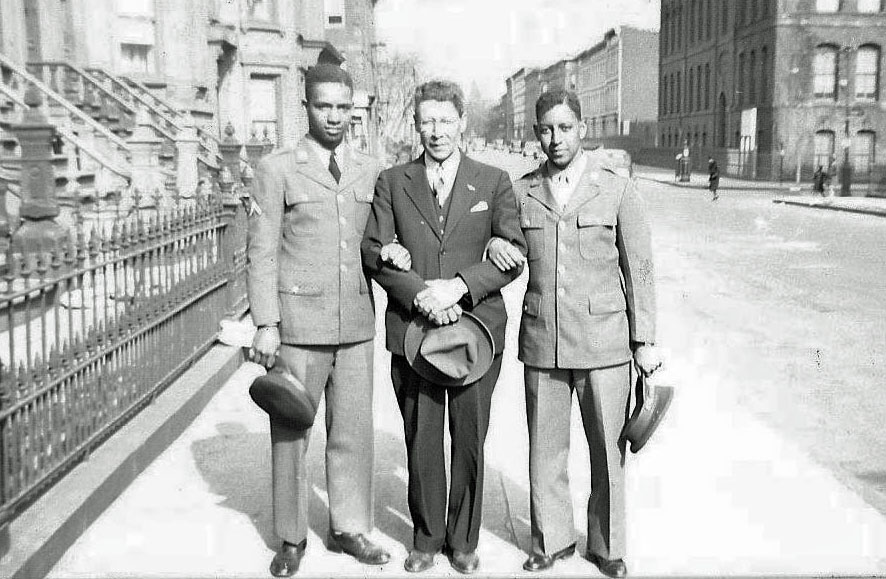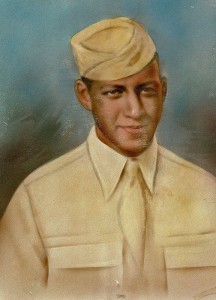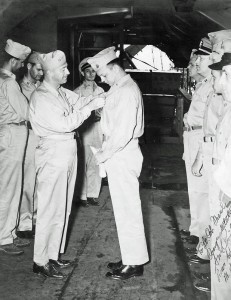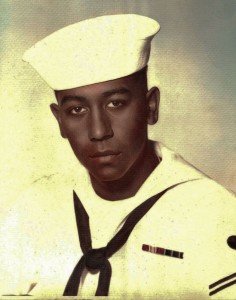True Tales from Canton’s Past: Crowd family
By George T. Comeau
Alfred Crowd (center) with his son Alfred Crowd III (right) in Brooklyn, NY (Courtesy of the Canton Historical Society)
Nellie Crowd is 90 years old, and on a visit to her husband’s hometown of Canton last August she found herself at the door of the Canton Historical Society. The locked door gave her pause, and the mission to Canton remained unfulfilled.
Nellie lives in Bloomfield, Connecticut, and these days she depends on her daughter to drive her 112 miles to make her pilgrimage. In the life of a nonagenarian, plans and appointments must be kept and Crowd decided to write a letter to Wally Gibbs asking for an appointment.
The note was simple: “I would like to stop by and see the military uniform of my husband and my son.” Both Alfred Crowd III and his son, Alfred Steven Crowd, had served proudly in the armed forces. Pretty much all of the Crowds are called Alfred, which can make genealogy complicated.
Most notably, the Crowds were Ponkapoag Indians and played a significant role in the development of Canton. According to Nellie, a Crowd served in the Spanish-American War, the Civil War, World War I and World War II, and through times of peace. One of the everlasting symbols of this dedication to our country is their uniforms. A military uniform is the embodiment of freedom and of our uniquely American values.
To prepare for Nellie Crowd, the Historical Society decided to mount an exhibit of some of the uniforms that could tell the story of World War II. At least three generations of Crowd uniforms are stored at the Histy. In a small room, with window darkened and under a clean linen sheet, Wally Gibbs, the society president, carefully removed Alfred Crowd’s World War II U.S. Army dress uniform.
Growing up at 71 Pond Street, Crowd was part of the greatest generation. “When all of young Alfred’s friends were going off to war, why he wanted to go right along with them,” explained Nellie. “He never really talked much about the war, but he saw a lot. He had been to England, Switzerland and Germany.”

A portrait of Alfred Crowd III during his service in World War II (Courtesy of the Canton Historical Society)
The Crowd family had cousins in New York City, and on a weekend leave from Virginia, Alfred Crowd did not have time to come up to Canton, so his family met him in Brooklyn. “A cousin, Alfred Phillips, introduced us, and I have to say I did not want to go out with him. I was seeing someone else at the time and it was not a great relationship, so I decided that I was off men forever. It took my brother and mother a week to get me to get out with him.”
Pretty much goading the young Nellie, her mother implored, “You are supposed to take care of the soldiers.” “So, I agreed,” she said. A well-chaperoned first date led to love. “We went to a place with cocktails … I had a Tom Collins, and after they talked me into it and after I made such a fuss, it turned out to be a good time.”
Alfred Crowd professed his love for the young nurse from Brooklyn, and on a warm Sunday afternoon, the very night after they met, he found his way back to their house at 1435 Dean Street. On a romantic walk under the tree-lined promenade, Alfred declared his intention to marry her. Returning to the war, Alfred sent volumes of letters to Nellie. Eventually Nellie was convinced and marriage was certain.
There are so many items of military significance in the Historical Society. And after Canton historian Ed Lynch died, his wife, Tara, donated seed money to start a fund for the preservation and archival storage of our most historic military uniforms. In 2009 the society commissioned Museum Textile Services to perform a survey of the 16 uniforms stored at the society headquarters on Washington Street. The survey looked at uniforms that date to the mid 19th century all the way through the Vietnam Era.
Preserving these military artifacts is an expensive project. Each uniform can cost between $330 and $600 to conserve, not including professional conservation dry-cleaning. Then there are the boxes and special supplies, all of which cost more than the fund receives. The society eagerly accepts donations to support the ongoing preservation efforts.
The uniforms must be vacuumed by hand and stored in acid-free boxes; special Tyvek and Mylar is used to buffer the clothing from dust and dirt and to ensure the fibers do not fray. Display has to be done in a controlled way so as to minimize tearing the fragile cloth.
To assume the care and storage of a military uniform is a great honor. The uniform of 1st Lieutenant Peter Hansen hangs in tribute to our Canton boy who died in Vietnam. Brewster Gifford recently donated his Korean War naval dress jacket, shirt and pants along with his service ribbons and epaulets. On the same rack hangs the Marine uniform of Brigadier General Willis A. Neal, USMCR.
General Neil lived in Canton on Spring Lane, and in the 1950s he served on the Zoning Board of Appeals as well as the position of clerk of the courts in Norfolk County. During World War II, at the rank of lieutenant colonel, Neill was part of the decisive Pacific campaign, bringing back hundreds of photographs and military orders, which he subsequently donated to the Historical Society.

Lt. Col. Willis A. Neil, shown receiving a citation, would later become a brigadier general in the U.S. Marines. (Courtesy of the Canton Historical Society)
Perhaps one of the most macabre and rare military items being displayed at the society is that of a Japanese sniper’s camouflage vest woven of coconut fibers and brought from the South Pacific by General Neil. This item is rare for both its historical value and as an insight into the work of the enemy during the war. To see the sniper vest is to imagine the fear in a young boy’s eyes facing the fact that the substance of war is kill or be killed.
As Nellie Crowd prepares for her trip to Canton, the curators at the Historical Society guide her husband’s uniform onto a dress form to support the clothing. Wally Gibbs carefully ties a knot in the rough wool tie and a helpful hand guides the buttons and belt across the jacket. “We were married in Washington, D.C. on September 4, 1942,” recalls Nellie. “He wore his uniform and he was so handsome. Standing five foot, seven (inches), he was as tall as can be on that day, and was the sweetest man in my life.” Seeing the uniform will be a bittersweet experience.
Alfred Crowd III died at home of a heart attack after a long day at work. “I remember him sitting on the back steps. It was 1975 and a beautiful spring day, yet he was complaining of pain in his arm, explained Nellie. “I took his pulse and had him lie down to rest. A few minutes later he died.”
Alfred Crowd was buried in Canton alongside his mother, father, grandmother, and uncles — all at Canton Corner Cemetery. Sometime after the funeral the Historical Society asked for his uniform, and Nellie donated it in memory of her husband’s love of his boyhood home.
Alongside the handsome brown jacket is a bright white Navy uniform, that of Alfred Steven Crowd, Nellie and Alfred’s only son. The younger Crowd joined the service in 1969, serving aboard the submarine U.S.S. Finback. For a long time the society did not know where this uniform came from or who wore it. Only when Nellie called earlier this year did she inquire if she could see both her husband and son’s uniforms.
Alfred Steven Crowd left the Navy and became a highly respected sergeant in the New York City Police Department, serving as a detective from the 73rd Precinct. Like the father, death came all too soon to the son. “He died of a brain tumor,” explained Nellie, “and as a nurse, I knew it was bad, not saying anything to anyone. I knew he was dying. There were three operations and the tumors grew. [It] was never Christmas without him and it still isn’t.”

Alfred Philip Crowd shortly after graduating from training in the U.S. Navy (Courtesy of the Canton Historical Society)
The day after Alfred Steven Crowd’s nephew was born, Alfred died. Seeing his uniform will bring back so many memories for his only sister and his mother.
That is what uniforms do; they bring back memories of those we love, of those who defended our country. The uniforms are an unbroken link to our liberties and the men and women who fought in foreign lands, leaving their families at home to grieve their time away. Each of the 16 uniforms has a story, a family, and a link to our past.
For Nellie Crowd, the story is simple: “This is my last trip to Canton. This week, I will be all right. Until it is time for me to be buried there … it is all arranged.”
Nellie will see her son and her husband again, in uniform and on display, and let the whole town know what the Crowd family means to Canton. God bless you, Nellie, and safe return home.
Several World War II uniforms and artifacts from the Pacific Campaign will be on display at the Canton Historical Society on Sunday May 13, and on May 27 and 28 in celebration of Memorial Day. Stop by and share Canton’s history. Call 781-828-0073 for more information.
Short URL: https://www.thecantoncitizen.com/?p=13562










